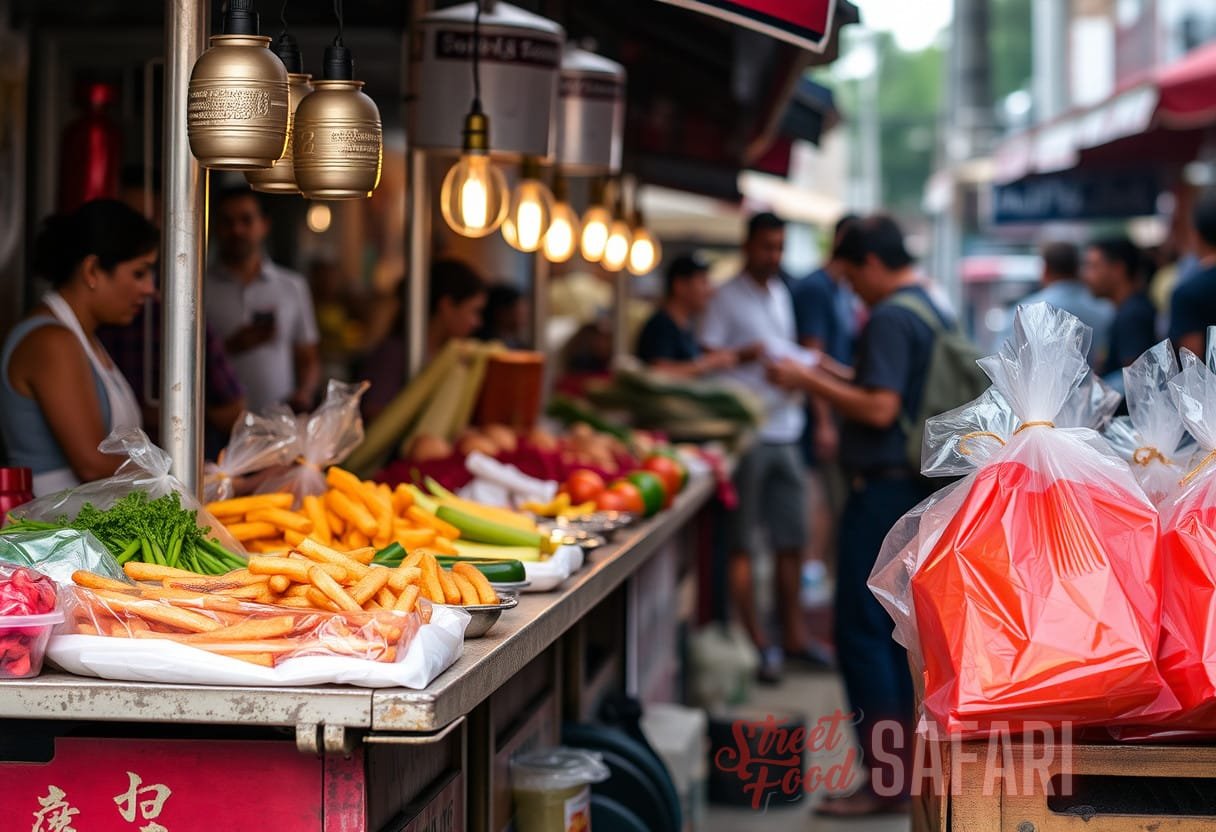Street Food Alchemy: The Cultural Chemistry Behind Global Culinary Innovations
Street food has evolved into a captivating arena where culinary traditions blend seamlessly with modern innovation. Across different cultures, street vendors are not just feeding the masses but are also serving as cultural ambassadors, offering a taste of their heritage with every dish. In this exploration, we will dive into the intricate world of global street flavors, unraveling the rich cultural threads that bind foods and communities together. This journey emphasizes how street food acts as a catalyst for culinary innovation and cultural exchange worldwide.
The Historical Context of Street Food
Street food dates back to ancient civilizations, where vendors provided quick, affordable meals to busy urban populations. In Ancient Rome, for example, street vendors sold fried fish and other foods to eager locals. This historical persistence underscores the universal need for convenient, delicious food options, particularly in bustling environments.
- Ancient Rome: Vendors sold street food like fried fish.
- Medieval Europe: Pies were commonly sold from stalls.
- Asia: Countries like China established night markets centuries ago.
Culinary historians note that the urbanization trends led to the rise of street food as we know it today. According to a 2019 report by the World Bank, organic growth in urban populations has made street food an integral part of daily life, particularly in developing countries.
The Cultural Chemistry of Street Food
Street food showcases a rich tapestry of cultural interactions, often embodying the fusion of various culinary techniques and flavors. Consider the following examples:
- Tacos al Pastor: Originating from Lebanese immigrants in Mexico, this dish combines the concept of shawarma with local Mexican ingredients, exemplifying how global street flavors can originate from migrant communities.
- Banh Mi: A Vietnamese sandwich that melds French bread with local fillings, reflecting the colonial history of Vietnam.
- Jerk Chicken from Jamaica: With African roots, it incorporates indigenous spices and cooking methods, showcasing the island’s diverse heritage.
This fusion results in culinary innovations that resonate with the populations experiencing these flavors, thus encouraging cultural exchange. The dynamic interaction between diverse culinary traditions prompts new culinary possibilities that continually reshape street food scenes.
The Impact of Globalization on Street Food
Globalization has dramatically reshaped the street food landscape. The availability of travel and technology has allowed street food vendors to share their culinary art to a broader audience.
According to a study by the United Nations, street food sales have increased by 20% globally in the past decade, indicating a burgeoning interest in these authentic experiences. This explosion of interest has led to:
- Emergence of global food trends, such as the rise of food trucks in urban areas.
- The influence of social media in popularizing unique street food options.
- The fusion of regional ingredients with international flavors, leading to innovative creations.
Case Study: Food Trucks in the United States
The United States has witnessed a wave of food truck innovations over the past two decades. According to the Statista, the number of food trucks has grown exponentially, from fewer than 2,000 in 2006 to over 30,000 in 2021. These mobile kitchens have been pivotal in introducing global street flavors to American palates.
Some notable food truck movements include:
- Korean BBQ Tacos: Combining Mexican tacos with Korean BBQ, this fusion has created an exciting culinary phenomenon.
- Vegan Ethiopian Cuisine: Food trucks serving plant-based Ethiopian fare have opened doors for innovative twists on traditional dishes.
- Artisanal Ice Cream: Many trucks have led the charge in using global flavors such as matcha or rosewater.
These food trucks not only serve delicious meals but also foster community engagement by offering unique cultural experiences that invite people to explore diverse culinary traditions.
Street Food Festivals: A Platform for Innovation
Street food festivals around the world play a crucial role in showcasing global street flavors. These events frequently allow vendors to experiment with and innovate their offerings, providing a platform for cultural expression. For instance:

- The Smorgasburg in New York City: This open-air food market features unique food vendors who regularly introduce new and inventive dishes.
- Street Eats in Australia: Showcasing a myriad of multicultural vendors, it highlights the diversity of flavors present in Australian cities.
- Hawker Centers in Singapore: A cornerstone of local culture, they are known for their innovation in street food offerings.
Street food festivals create a vibrant ecosystem where culinary innovation thrives. They provide consumers with an opportunity to experience diverse flavors while allowing chefs to push the boundaries of their craft. The blending of cultural elements that emerges is a testament to the dynamic nature of street food.
Health and Safety in Street Food
The rise of street food has raised important questions regarding health and safety standards. Organizations, including the World Health Organization (WHO), have emphasized the necessity of regulating food safety practices across vendors to avoid health risks. Ensuring testing for:
- Bacterial contamination
- Food integrity
- Environmental sanitation
Addressing these standards is crucial; improper handling can detract from the consumer experience and threaten public health. A 2021 study by the Journal of Environmental Health found that up to 76% of food-related illnesses in urban areas are linked to street food consumption due to insufficient safety practices. As the street food scene continues to grow, regulatory frameworks must keep pace to maintain consumer trust.
Innovative Techniques in Street Food Preparation
Modern street food vendors increasingly incorporate innovative cooking techniques and technologies to appeal to a broader customer base. Techniques such as sous-vide cooking, fermentation, and molecular gastronomy are making their way into street food offerings, resulting in enhanced flavor profiles and presentation. These innovations not only elevate the street food experience but also attract culinary enthusiasts interested in tasting the next big trend.
- Sous-vide: Preparing proteins at controlled temperatures for perfect doneness.
- Molecular Gastronomy: Using chemical reactions to create unique textures and flavors.
- Fermentation: Enhances flavors and adds nutritional benefits to traditional dishes.
These methods expand the traditional notions of what street food can be, turning simple meals into gourmet experiences without losing the authenticity that customers seek.
The Role of Technology and Social Media
Social media platforms are instrumental in the rise of street food popularity. Vendors effectively use social media to showcase their dishes, share their stories, and connect with customers, driving traffic to their stalls.
Statistics show that 70% of millennials seek food inspiration through Instagram, making it a key platform for street food marketing. Many vendors create visually stunning dishes designed specifically for social sharing, reflecting a cultural shift in how food is perceived and consumed.
This digital engagement allows for greater interaction between vendors and consumers, creating communities around food. As interactions increase, the boundaries separating cultures and flavors begin to blur, giving rise to an exciting new wave of global street flavors.
The Future of Street Food
The future of street food promises a continued evolution influenced by globalization and technological advancements. As culinary boundaries shift, so will the specific flavors represented in street food offerings. Expect to see:
- Increased Vegan and Plant-Based Options: A response to global sustainability trends.
- Integration of AI and Robotics: Influencing how food is prepared and served.
- Culinary Education Programs: For aspiring street food entrepreneurs to learn best practices for innovation and safety.
The street food landscape will undoubtedly continue to shape culinary trends while remaining rooted in its vibrant cultural origins. Each innovation represents a blending of global street flavors, engaging communities and sparking interest across nations.
Closing Remarks on the Cultural Significance of Street Food
In summary, street food serves as more than just a source of nourishment; it is an essential aspect of cultural identity and innovation. The rich tapestry of global street flavors embodies the complexities of a shared culinary heritage. As urban populations continue to grow, street food vendors will likely remain at the forefront of culinary creativity, making invaluable contributions to the socio-cultural landscape worldwide.


